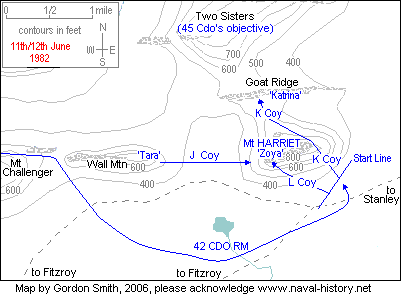Battle of Mount Harriet
The evening of 11 June 1982 saw the Battle for Mount Harriet, one of the major conflicts of the Falkland Islands War, begin. It took place as part of the Task Force’s bid to remove the height advantage the Argentines had by being stationed there.
The battle, which took place alongside the Battle for Two Sisters, began with a naval bombardment that immediately killed two Argentine soldiers, wounding others. The Argentine troops that were stationed on Mount Harriet gained a strong height advantage and the British Task Force sought to remove that by capturing the mount. The position had to be attacked if the Task Force’s path to the Falkland Islands’ capital, Port Stanley, was not to be made even more dangerous. Port Stanley lay just a few miles away from Mount Harriet, so it was crucial for the British to get the location under their control.

British war correspondent, John Witheroe, described the start of the battle, saying:
“We were involved with one night attack on Mount Harriet, when the Welsh Guards were coming up as a back-up. This involved marching for several hours on a very dark night, through a minefield. Sporadic shellfire slowed our progress tremendously. Eventually we made the base of Mount Harriet, which was coming under incredible fire from a frigate off shore. The whole mountain seemed to erupt in flame. It seemed impossible that anybody could survive an attack like that. This went on for well over an hour, shell after shell whistling over our heads and hitting the mountain. Eventually this was lifted and the Marines went in. To our amazement, there seemed to be an incredible amount of fighting going on. There was a lot of tracer fire. The whole night was being lit up by flares, which cast a dead, unrealistic, pall over the whole scene.”
Fighting the battle for the British was 42 Commando, Royal Marines, supported by the 7th Battery, 29 Commando, Royal Artillery and ships including HMS Yarmouth. Leading 42 Commando was Lieutenant Colonel Nick Vaux, who took his men into battle against soldiers from the Argentine 4th Infantry Regiment.
42 Commando met at Mount Challenger on 30 May and began exploring the slopes of Mount Harriet to check for defences made by the Argentines. It was found to be well defended. Vaux opted to launch his attack on the mount from the south, as to approach from the front or the north would interfere with the 45 Commando, Royal Marines attack on Two Sisters which was taking place at the same time. The Welsh Guards were readied to secure the Start Line for L and K Companies, while J Company was asked to stay on Wall Mountain, which lay to the west of Mount Harriet. They were told to attack from the front once L and K Companies were distracting the Argentine defenders in the area. L Company was told to begin the attack at 20.30 on 11 June, starting from the southwest side of Mount Harriet, a move which would hopefully draw away Argentine defenders from their trenches. At this point, K Company could then make an attack on the southeast section of the mount at 21.30. J Company would the move from Wall Mountain after the area had been declared free of dangerous mines.
‘Noisy’ was a word used to described the Battle of Mount Harriet, which began with artillery bombardment. K and L Companies did not manage to coordinate with the Welsh Guards, leading to a delay in the start of the attack, which did not begin until 22.00. Argentine snipers on Goats Ridge provided difficulties for the British soldiers, but L Company made use of Milans to wipe out heavy machine gun banks and sniper nests. J Company advanced as Vaux had wanted from Goats Ridge and men from Naval Party 8901, who had been taken prisoner by Argentine Army and then repatriated on the first day of the conflict – were also involved.
Vaux’s statement;
“The enemy are well dug-in in very strong positions but I believe that once we get among them they will crack pretty quickly,” proved spot on. The 4th Infantry Regiment surrendered quickly as a result of strong artillery fire from the British. The 7th Battery, 29 Commando, Royal Artillery, also helped with the assault, causing the Argentine men to withdraw quickly, seeking cover from the 3,000 rounds of ammunition and shells fired by the British. 42 Commando lost two men in the battle and took 300 Argentine men prisoner. They received service medals for bravery following the attack, including one Military Cross and four Military Medals.
See also:
MLA Citation/Reference
"Battle of Mount Harriet". HistoryLearning.com. 2024. Web.
